Movie Review – Fight Club
– Summary –
Director : David Fincher
Year Of Release : 1999
Principal Cast : Edward Norton, Brad Pitt, Helena Bonham Carter, Meat Loaf, Jared Leto, Zach Grenier, Richmond Arquette, George McGuire.
Approx Running Time : 139 minutes
Synopsis: An insomniac office worker, looking for a way to change his life, crosses paths with a devil-may-care soap maker, forming an underground fight club that evolves into something much, much more…
********
The first rule? That’s what we’re here to do, chump.
At the end of last century (and man, do I feel old even typing that), two films came along that polarized audiences, crystallized genres, and gave rise to the reborn medium of cinematic storytelling. While one film would divide critics and audiences initially, its success on the then-nascent DVD format turned it from a mild box-office success into a pop-culture juggernaut that, to this day, resonates with men of all ages. The other film would become imitated and parodied for years afterwards, and while equally as cataclysmic to pop-culture, had an enormously successful run in theaters, culminating in two back-to-back sequels a few years later.
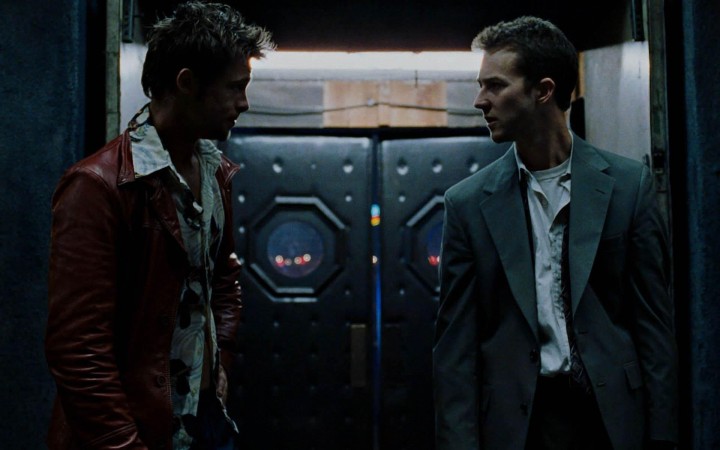 I’m talking, of course, about Fight Club and The Matrix, two of 1999’s most memorable films (outside of, perhaps, the less intelligent but still hugely effective The Sixth Sense); Fight Club’s anarchistic narrative and slick, post-processed visual aesthetic – not to mention it’s jaw-dropping twist ending – have seen it become enshrined as a vaguely masculine cultural touchstone, in no small part thanks to Brad Pitt’s charismatic performance, and Ed Norton’s “everyman character”. Where The Matrix tapped into that fantasy world we craved in which the impossible was possible, Fight Club’s grungy sense of masochistic narcissism bestowed on audiences an extrapolation of themes including consumerism, personal responsibility, cultism and masculine elitism which, in the years prior to the GFC, seemed to resonate with viewers at an almost cathartic level.
I’m talking, of course, about Fight Club and The Matrix, two of 1999’s most memorable films (outside of, perhaps, the less intelligent but still hugely effective The Sixth Sense); Fight Club’s anarchistic narrative and slick, post-processed visual aesthetic – not to mention it’s jaw-dropping twist ending – have seen it become enshrined as a vaguely masculine cultural touchstone, in no small part thanks to Brad Pitt’s charismatic performance, and Ed Norton’s “everyman character”. Where The Matrix tapped into that fantasy world we craved in which the impossible was possible, Fight Club’s grungy sense of masochistic narcissism bestowed on audiences an extrapolation of themes including consumerism, personal responsibility, cultism and masculine elitism which, in the years prior to the GFC, seemed to resonate with viewers at an almost cathartic level.
I mention Fight Club and The Matrix in similar breathy tones mainly due to both films’ narrative complexity and textual density – while The Matrix’s religious and humanistic themes touch on everything from Christianity to Buddhism and destiny, fate and futurism, Fight Club’s closer-to-home immediacy is redolent of rampant consumerism and disassociative psychopathy we see so strongly in today’s world.
Fight Club is based on Chuck Palahnuik’s 1996 novel of the same name (I’ve never read it, to be clear), and while large portions of the dialogue in the film are snappy, stream-of-consciousness diatribes by Ed Norton’s character, who remains unnamed throughout the film and is credited only as “the narrator”, there’s a definite sense of literacy about both the screenplay and Fincher’s direction of it. Fight Club’s portentous examination of society’s gradual decay, mirrored in the broken, grimy, polluted existence of both Norton’s narrator and Brad Pitt’s Tyler Durden, as well as their eventual gang of anarchists called “Project Mayhem”, is an examination of moral, ethical and social decay we see today. From playground bullies to the infatuation with social media and our ability to jag 15 minutes of fame so so quickly, the themes of Fight Club’s usurping societal mandate are as honest as they are doggedly on-point.
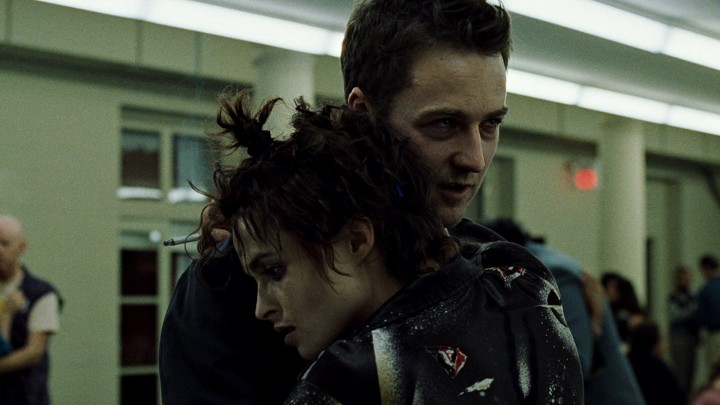 The narrator, Norton, is a typical office drone, spending his time flitting across the country assessing insurance claims. His life is boring, filled with purchasing “shit he doesn’t need” to somehow satisfy his own existence, while taking to attending support groups to elicit any sense of emotion in his otherwise flat, beige life, and to counteract his rampant insomnia. At a meeting, he meets another support group impostor, Marla (Helena Bonham Carter), in whom he sees both a kindred spirit and something of a reflection of himself. The Narrator also crosses paths with Tyler Durden (Brad Pitt), a soap salesman who, as it turns out, is something of an anarchist and social pariah; the two become friends, and form an underground group who fight each other, known as “fight clubs”, and gradually, grow a small army of like-minded men for whom the allure of Durden’s personality is too strong and urge to resist. Durden’s anarchism stretches into forming a group of vigilantes known as “Project Mayhem”, who do their best to usurp control of the ruling class and create all manner of disorder and discontent. But when the narrator learns of Durden’s ultimate plan, a catastrophic city-leveling series of explosions, he begins to suspect that Durden’s way possibly isn’t the right way.
The narrator, Norton, is a typical office drone, spending his time flitting across the country assessing insurance claims. His life is boring, filled with purchasing “shit he doesn’t need” to somehow satisfy his own existence, while taking to attending support groups to elicit any sense of emotion in his otherwise flat, beige life, and to counteract his rampant insomnia. At a meeting, he meets another support group impostor, Marla (Helena Bonham Carter), in whom he sees both a kindred spirit and something of a reflection of himself. The Narrator also crosses paths with Tyler Durden (Brad Pitt), a soap salesman who, as it turns out, is something of an anarchist and social pariah; the two become friends, and form an underground group who fight each other, known as “fight clubs”, and gradually, grow a small army of like-minded men for whom the allure of Durden’s personality is too strong and urge to resist. Durden’s anarchism stretches into forming a group of vigilantes known as “Project Mayhem”, who do their best to usurp control of the ruling class and create all manner of disorder and discontent. But when the narrator learns of Durden’s ultimate plan, a catastrophic city-leveling series of explosions, he begins to suspect that Durden’s way possibly isn’t the right way.
If you asked me to pick a favorite film from 1999, it would be a flip of the coin between Fight Club and The Matrix. Both are films I could watch ad nauseum, the kind that bear repeated viewings due to picking loads of clues, hints, clever touches and chain-links in the storytelling that many will miss on first, second, even third viewings. Fight Club’s famous twist ending, which is almost as shocking as The Sixth Sense’s from the same year, will leave first-time viewers with their jaws on the floor, although I suspect virgin viewers may be aware of the narrative sucker-punch inflicted by Fincher due to its immersive nature within our cultural fabric. Like the discovery of Vader being Luke’s father, the revelation towards the latter stages of Fight Club is just as impactful, just as neck-snapping, just as magnificently hidden in plain sight. No, even for a film approaching its twentieth anniversary in a few years, I’m not going to spoil it; if you’re reading this and have yet to see Fight Club for whatever reason, then I hope your first time is just as awesome as mine was back in the day.
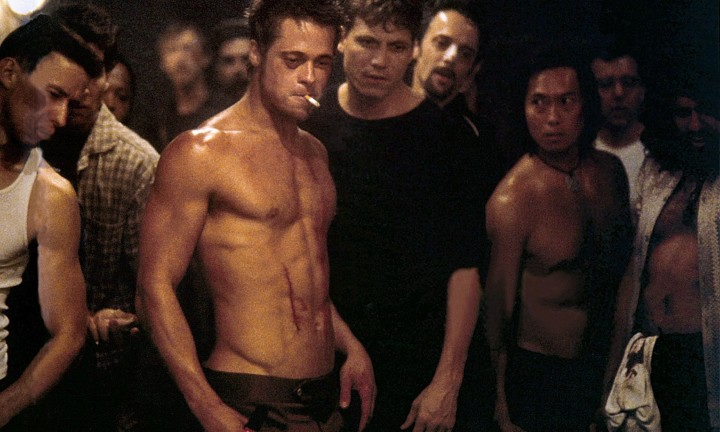 Although I could probably write pages and pages of dissection on Fight Club’s incredibly detailed themes, for the sake of brevity I’ll keep it to just the overarching quality of the film itself. Take it as read that Fight Club’s complexity over and above any visual motifs bear up to repeated viewing but also deep examination, the kind novels of their own are written about. Fincher, coming off Se7en and The Game (Jesus, this was only his fourth feature film!) came to Fight Club wary of producing studio 20th Century Fox, with whom he’d had an acrimonious relationship since the debacle of Alien 3. Although he wasn’t the first choice director for producer Ross Bell, who named Danny Boyle, Peter Jackson and Bryan Singer as contenders for the project, luckily, most were otherwise occupied with other projects and couldn’t make it work, save for Fincher.
Although I could probably write pages and pages of dissection on Fight Club’s incredibly detailed themes, for the sake of brevity I’ll keep it to just the overarching quality of the film itself. Take it as read that Fight Club’s complexity over and above any visual motifs bear up to repeated viewing but also deep examination, the kind novels of their own are written about. Fincher, coming off Se7en and The Game (Jesus, this was only his fourth feature film!) came to Fight Club wary of producing studio 20th Century Fox, with whom he’d had an acrimonious relationship since the debacle of Alien 3. Although he wasn’t the first choice director for producer Ross Bell, who named Danny Boyle, Peter Jackson and Bryan Singer as contenders for the project, luckily, most were otherwise occupied with other projects and couldn’t make it work, save for Fincher.
In putting his own stamp on the film, Fincher employed a decidedly grim visual palette for the movie, as the narrator’s journey with Durden becomes more and more degraded, the film’s color is sucked out in favor of urine-hued yellows, purple-infused browns and a frisson of orange, blue, and flat white. The film’s opening act, in which Norton’s narrator regales us with his lifestyle to that point, is tonally drab, a grey-white monotonousness that reflects the character’s own oscillatory lifestyle. The narrator isn’t moving forward in his life, and the color scheme reflects that. With the arrival of both Marla (a terrific Bonham Carter) and Durden, however, the film changes gears both in terms of visual aesthetic and emotional resonance. Durden’s ability to transform the narrator’s life into a pain-bleak cacophony of bruises and brutality, anti-social anarchism and self-reflective philosophy, is paralleled by Fincher’s use of color – or lack thereof – to show the gradual decay in removing social order and constructed “perfection” from a person, and it works tremendously.
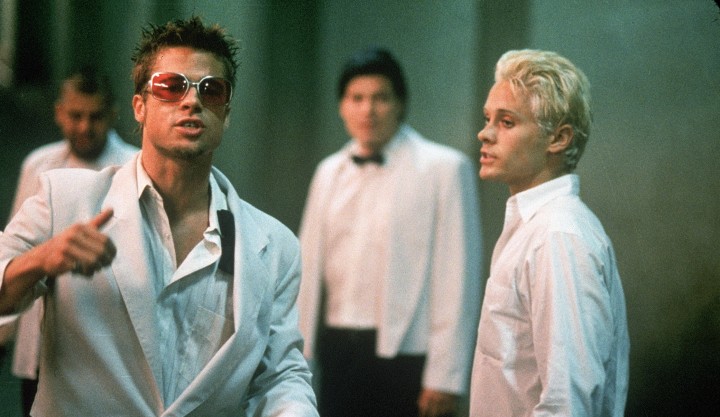 The film is exceptionally violent, both physically and intellectually. While the titular “fight clubs” are essays in brutal masculine release, and Norton’s sexual relationship with Marla impinges on men’s objectification and non-linear acceptance of lovemaking as a purely physical act (whereas women find an emotional connection with it), the film tackles some rather taboo and controversial subjects with the nuance of throwing a frag grenade into a kindergarten. Mostly, it’s a dissertation on the recession of men as men, more as shadows of men within our society – Durden sees the onset of social decay as being the fruit of men not holding up their end of the human bargain. Whereas men were once the literal hunters of humanity, who ruled the Earth with weapons and a sense of entitlement, now through feminism and gradual moral ebbing the order is changing, and Fight Club attends to make a statement about that. Whether Fincher’s chosen sledgehammer method is a great way to depict it is matter for a debate elsewhere, but I suspect for the majority of younger viewers (like myself at the time), the film struck a particularly resonant chord.
The film is exceptionally violent, both physically and intellectually. While the titular “fight clubs” are essays in brutal masculine release, and Norton’s sexual relationship with Marla impinges on men’s objectification and non-linear acceptance of lovemaking as a purely physical act (whereas women find an emotional connection with it), the film tackles some rather taboo and controversial subjects with the nuance of throwing a frag grenade into a kindergarten. Mostly, it’s a dissertation on the recession of men as men, more as shadows of men within our society – Durden sees the onset of social decay as being the fruit of men not holding up their end of the human bargain. Whereas men were once the literal hunters of humanity, who ruled the Earth with weapons and a sense of entitlement, now through feminism and gradual moral ebbing the order is changing, and Fight Club attends to make a statement about that. Whether Fincher’s chosen sledgehammer method is a great way to depict it is matter for a debate elsewhere, but I suspect for the majority of younger viewers (like myself at the time), the film struck a particularly resonant chord.
The film’s violence isn’t relegated to the fisticuffs between characters, either. Mid-air plane explosions, car crashes, explosions and suicidal gunshots make up a vast contingent of savage, shocking, affecting counterpoints to Durden’s delirious rantings. Fincher’s keen eye for detail and smooth, strong framing make Fight Club a legitimate tour-de-force of visual acumen writ large, a modern parallel to, say, Orson Welles and Citizen Kane. I think both Fight Club and Citizen Kane, although separated by decades of technical and political disparity, have decidedly similar techniques that gather the audience, soothe them, and then shock and surprise them in ways we hadn’t seen on the screen beforehand. Fincher’s hold-edit on the exploding plane sequence, still one of the most astonishing visual effects scenes I’ve seen on film, is exquisitely painful, a shock-and-awe moment that rips us from the comfort of our chair (or cinema seat) and into a mid-air experience we’ve all often wondered about. Then, later, Durden and the Narrator are involved in a car crash (along with a couple of Project Mayhem’s lackeys), and the visceral nature of this sequence is as close to being in a car wreck as one would wish to be. As part of the film’s finale (and without giving away much at all, honestly), the Narrator attempts suicide by gunshot, a blast of uncompressed ferocity both aurally and visually that will make almost any audience member jump upright in shock.
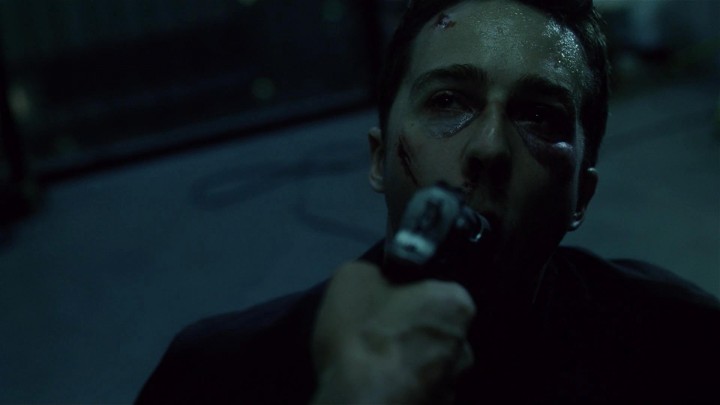 Fincher’s unafraid to take risks here, with his use of CG and practical effects, and Fight Club’s overall technical work holds up even by today’s high-definition standards. The film was shot on Super 35, but graded and fiddled with digitally, allowing the use of colors and effect unachievable before, to create a suffocating blanket of misanthropy and disgust as these character engage in their unholy works. The film’s score, by the Dust Brothers, is an entirely unique mix of pounding electronic sampling and discordant, nonsensical rhythm that just works. Easily one of my favorite scores from the 90’s.
Fincher’s unafraid to take risks here, with his use of CG and practical effects, and Fight Club’s overall technical work holds up even by today’s high-definition standards. The film was shot on Super 35, but graded and fiddled with digitally, allowing the use of colors and effect unachievable before, to create a suffocating blanket of misanthropy and disgust as these character engage in their unholy works. The film’s score, by the Dust Brothers, is an entirely unique mix of pounding electronic sampling and discordant, nonsensical rhythm that just works. Easily one of my favorite scores from the 90’s.
The film’s cast are simply sublime in their respective roles. Norton and Pitt carry the film, demolishing any “good guy” looks they might have carried into the project (Pitt famously had his teeth broken and chipped by a dentist to appear legitimately “banged up” for the role) and while Pitt’s later roles would earn him critical and industry respect, I think Fight Club is an early reminder of just how magnetic and personable his on-screen performances could be. Durden’s an anarchist, a leprechaun of society, an outbreak of influenza or the plague within the film’s narrative – he’s a catalyst, a pivot point, an active virus in the workings of society, and Pitt’s naked tenacity on the screen is indeed as charming and terrifying as ever. Norton, who spends a large portion of the film looking slack-jawed at all Durden achieves, which includes inserting frames of male genitalia into children’s films, as well as several meta-references to the film itself, is solid as the character on which the entire film depends. Norton’s “everyman” persona, his ability to morph into us, is never more clear as it is here, and although the trajectory of the character is clear from trip hazards such as emotion or ethics (until the end, at least), he represents a fairly liberal moral code that, if not for constant reminders by a commercial-driven society demanding men act, look and be a certain way, isn’t to far removed from where we are now.
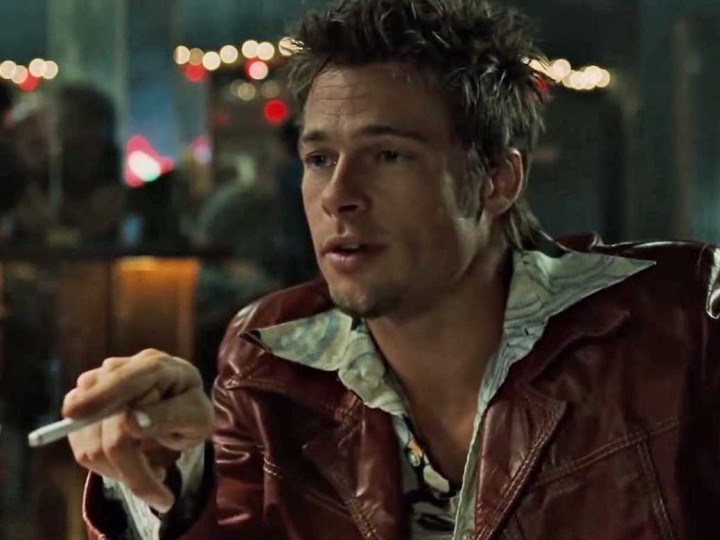 Helena Bonham Carter’s performance as Marla is suitably deranged, the kind of Gothic, Tim Burton-esque appearance representative of how many men perceive women – unfaithful, fake, sexually promiscuous, perhaps altogether deranged (!), in a post-modern echo of the film’s own mantra of anti-socialism – and she nails the part’s scattershot whimsy with panache. The film sees Jared Leto appear as one of Project Mayhem’s early members, while rocker Meat Loaf is brilliantly convincing as an overweight wannabe Mayhem groupie with enormous manboobs and a desire to spread dissent wherever he can. Zach Grenier plays the Narrator’s boss, and in a key scene where the Narrator beats himself up to make it look like his boss is doing it, the scene is sold not so much in Norton’s performance but by Grenier’s reaction to it. A genuine LOL moment in a dark, altogether nihilistic film.
Helena Bonham Carter’s performance as Marla is suitably deranged, the kind of Gothic, Tim Burton-esque appearance representative of how many men perceive women – unfaithful, fake, sexually promiscuous, perhaps altogether deranged (!), in a post-modern echo of the film’s own mantra of anti-socialism – and she nails the part’s scattershot whimsy with panache. The film sees Jared Leto appear as one of Project Mayhem’s early members, while rocker Meat Loaf is brilliantly convincing as an overweight wannabe Mayhem groupie with enormous manboobs and a desire to spread dissent wherever he can. Zach Grenier plays the Narrator’s boss, and in a key scene where the Narrator beats himself up to make it look like his boss is doing it, the scene is sold not so much in Norton’s performance but by Grenier’s reaction to it. A genuine LOL moment in a dark, altogether nihilistic film.
Fight Club is one of those films labeled as “great” by a vast majority, but unlike many with the tag, actually deserves it. The film’s complex themes and sweaty, pulsating storytelling mechanisms are an engrossing, shocking, entertaining, terrifying look into a side of masculinity that will abhor many, anger a few, and elicit some scary “hell yeah’s” from possibly too many. Films such as Fight Club only come along once in a generation; I think it’s this generation’s Citizen Kane, a film (if I can borrow from Marvel’s Loki for a moment) burdened with glorious purpose. Dissecting a frail masculinity, debauching a society already overly debauched with commercial greed, pornographic sexualization of minors, and discontent at authority, Fight Club’s explicit themes and testosterone-infused style will engender a catharsis or an embolism, depending on your ability to think laterally. Frankly, it’s one of the best films of the 90’s, and hell, easily in the top 10 of the last 50 years, hands down.
Although possibly not changing cinema in the way The Matrix did, Fight Club captured a zeitgeist movement towards masculine androgyny that seems more culturally acceptable today. In an era where men are made to feel de-manned (can’t think of a better way of phrasing it) by a proliferation of homogeny, Fight Club’s battering ram assault on sexuality, society, commercialism and philosophy are as refreshing now (even moreseo, perhaps) as they were back in 1999.


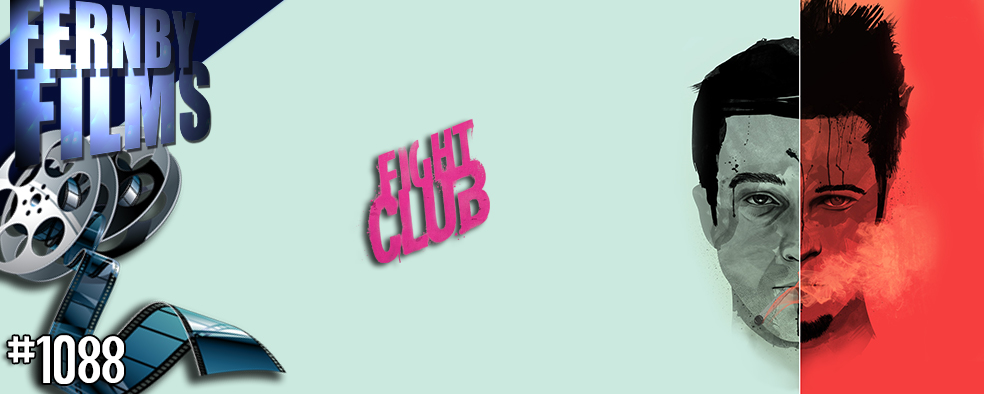

 Review – Gone Girl
Review – Gone Girl
 Top 10 Greatest Female Film Characters
Top 10 Greatest Female Film Characters





Everything you wrote it true. I agree 100%. But, for whatever reason, I don't really like the film that much. I just can't get into it. There's something about it that just doesn't hook me. I feel like the movie is too smug, or perhaps pretending to be more insightful than it really is. Like bringing up all these issues of societal degradation, and then moving on to the next deplorable thing without further examination or offering up of solutions. Maybe. I don't know. Something about it feels off to me. I can't explain it. I agree that it is a masterwork on a technical level, but it's just not for me.
Ya what? You didn't get into this one? Oh man…. *shakes head*
Ahh well, each to their own. I think it's subversiveness and ethical exploration of human degradation was handled really well, very meta.
Great review! I do recommend reading the novel but be aware it's definitely not as good as the film. There are just a few changes but they all improvements for the film.
I've never read the book because I've heard similar reports, and don't want it to ruin the film for me. I'm just happy to have a film version that's so awesome!